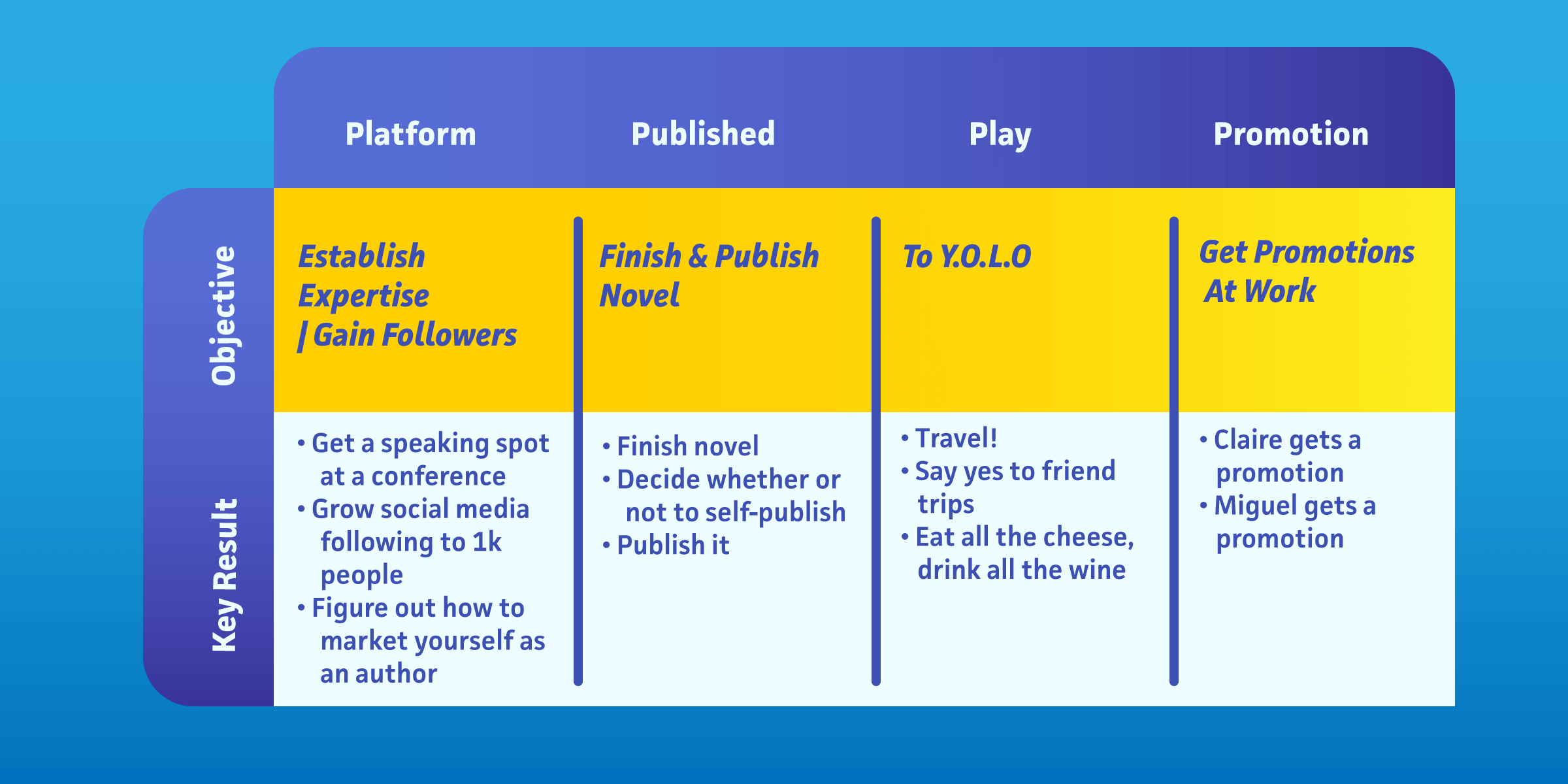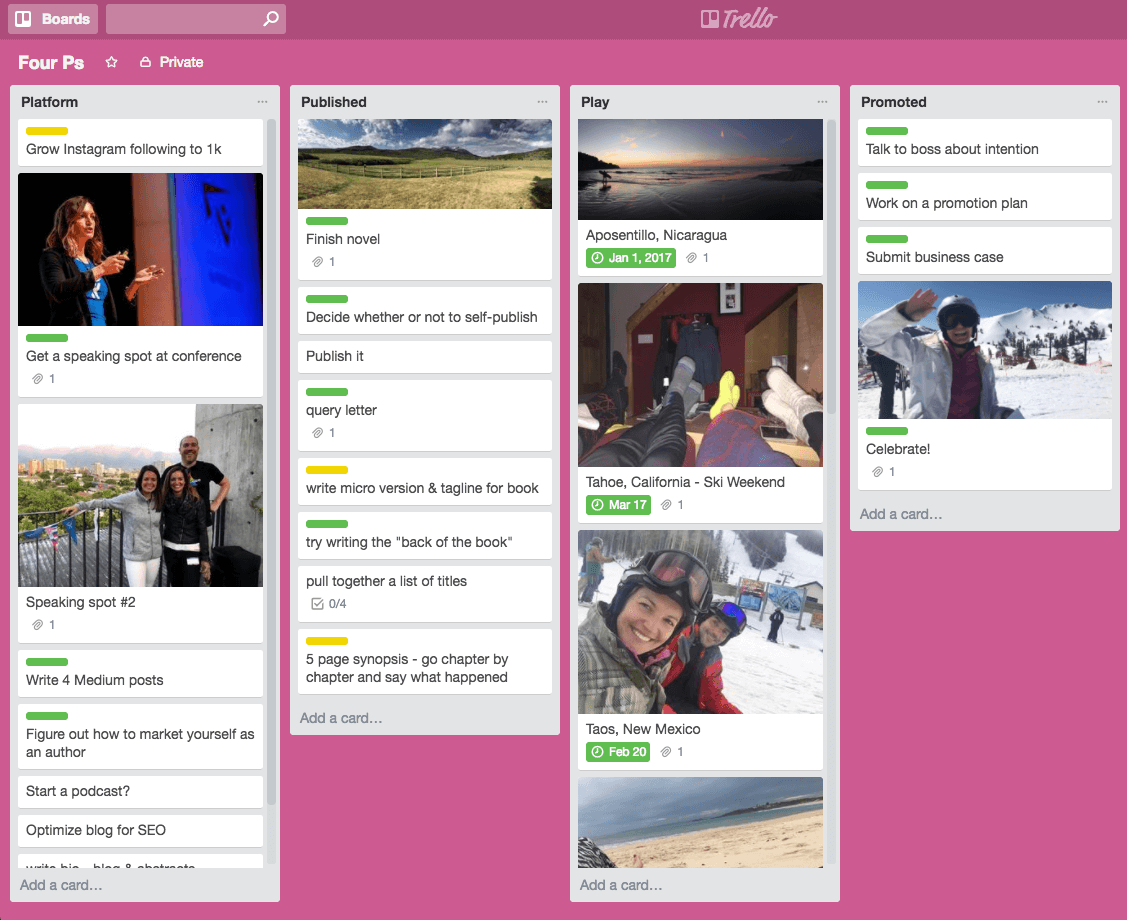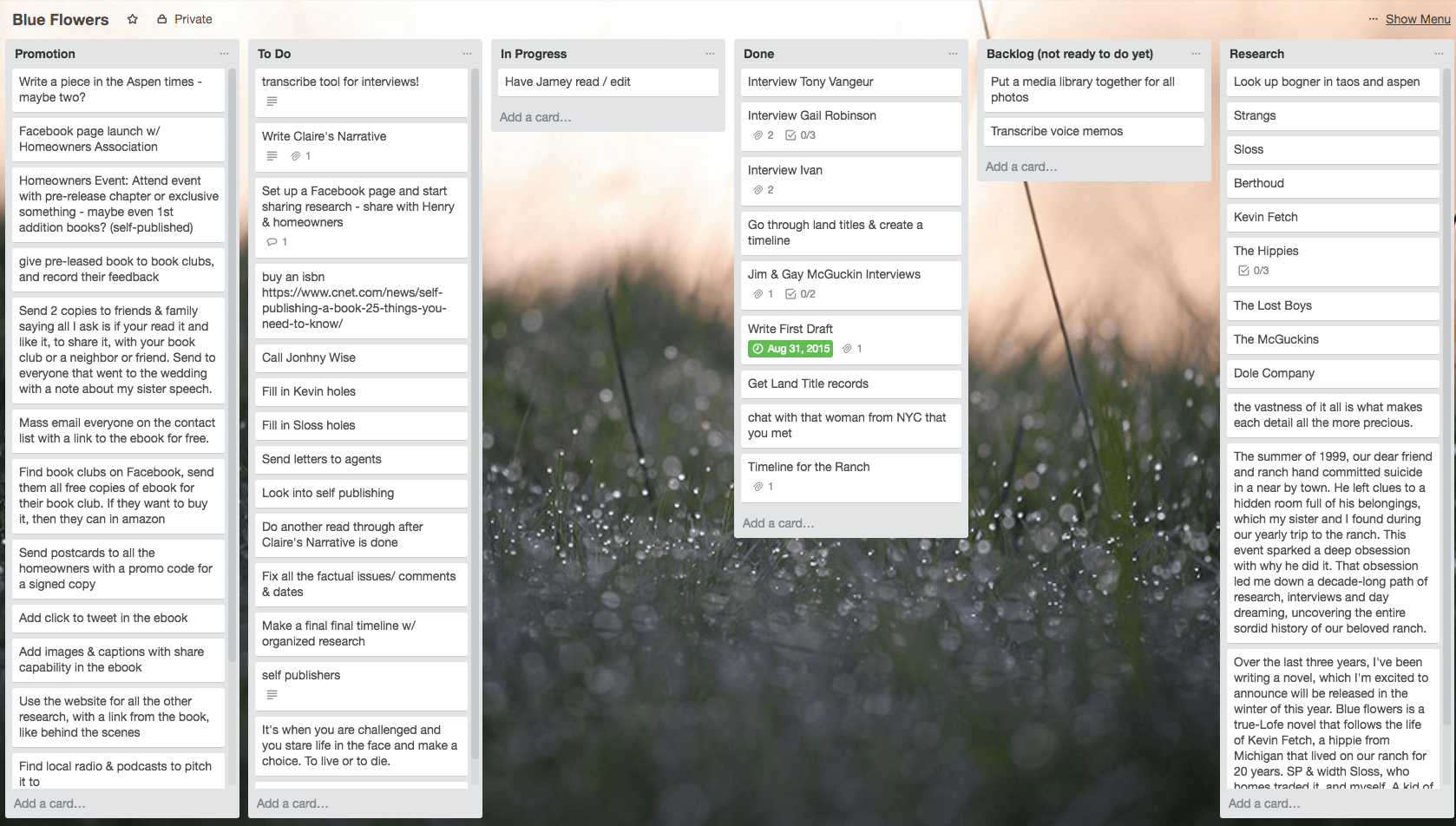Here’s a sad fact: Only 8% of people keep their New Year’s resolutions. At the end of last year, I started making some big plans for 2017. But I realized I needed something better than a promise to myself to reach my goals. I needed personal OKRs.
At Atlassian, we set goals and make plans using the OKRs (Objectives and Key Results) framework. Every quarter, we lay out goals (the ‘O’s) and measurements (‘KR’s) to help our teams focus their effort on what’s most important for the company. I’ve seen my team hit some pretty big numbers using OKRs as the guiding light. So I thought, why not try out this type of goal setting on myself?
At the end of 2016, my husband and I had a long talk about all the things we wanted to do. (Pro tip: Having this chat with my partner was the first step to success.) Our first goal was to have fun and travel together—something we had been neglecting in recent years due to remodeling a house. But we didn’t want to stop there.
We wanted to have fun while knocking some big items off the bucket list. We laid out our OKRs as the Four Ps: Promotion, Platform, Published, and Play. And because all good things come with a hashtag, we dubbed the year-long plan #Yolo17.
Putting A Personal Plan In Action
Full disclosure, we’re both in tech and have strategic and planning-focused jobs. We’re planners. List people. So once we had the theme (#Yolo17) and objectives (The Four Ps), the rest should have fallen naturally into place. I mean, we do this for a living, so it should be easy to do for my personal life, right?
Wrong.
Applying work practices to your personal life is really hard. You don’t have a team to help you execute, nor a boss holding you accountable, or deadlines, or really anyone motivating you other than yourself. And when the work is done, let’s be honest, no one really cares. No one cares if I hit my “Play” OKR. In fact, people are probably just annoyed by seeing it on my Instagram.
If I was going to take this seriously, I had to make the people around me take it seriously. I wrote the entire plan for the year, including key results, tactics, and even some strategy in a Google Doc. And then I shared it with everyone that would be impacted by it. My boss, my friends, my family, all the strangers that follow me on social media, and my dogs.
Even though this sounds ridiculous, it was actually the most crucial part. “I can’t come to your wedding because I’m in Aspen to interview some people for my book…” Is a little easier to swallow with: “Because it’s a personal goal of mine, and you have to make tradeoffs in order to accomplish big goals.”
Here’s a snapshot of my OKRs:

The Execution
Simply writing the plan down felt both invigorating and daunting. There was a lot to do. As any productivity nerd will tell you, the way to combat big, daunting tasks, is to break it down into small, shippable chunks of work.
That’s where Trello came in.
I built a Trello board called “The Four Ps.” I used Trello because I wanted to see visual progress I was making towards my goals. I wanted to keep task lists and notes and photos all in one place. It was less about project managing my goals in a kanban board with status columns, and more about seeing progress for big milestones and checking “Done.” If you get a kick out of checking “Done” like I do, this is the perfect way to give yourself a little positive reinforcement along the way. Plus, look how pretty it is!

For the OKR board, I kept it high-level. I added the “Why” to a card at the top of each column, to remind myself of why I was doing this. Then I started listing all the things I thought it would take to feel that each goal was complete.
For the “Play” list: My husband and I sat down for an hour with a calendar and plotted the entire year out, making sure no three-day weekend went unplanned. This of course, took some adjusting because work trips came up along the way. For example, I went to Australia, Hawaii, Portugal and Chile with work. The good news was I could surf at two of the four places. The bad news was it was without my husband.
For the “Promotion” list: We both committed to create space for the other to really focus on their jobs. This was really hard because we did a lot of traveling apart, worked late nights and early mornings, and sometimes felt like ships passing in the night. I was glad this goal was balanced out with our commitment to “Play,” because it was both needed and necessary to keep us motivated and happy. I’m also pleased to report that we both got promotions this year.
The “Published” goal was my stretch goal. Finishing a novel was the thing I wanted to do the most, required the most personal commitment, and was the hardest to achieve. For this, I hired a writing coach. I needed an outside perspective, motivator, and mentor to help me break the work down and steer me in the right direction. I would recommend this to anyone who has a similar stretch goal. Coaches aren’t just for sports.
I also ended up making a separate Trello board to manage this project. My book is nonfiction and required a ton of research, which made it even more challenging. This board was for project management rather than motivation, with To Do, In Progress, and Done columns.
I also kept notes and ideas here. Having a single source of truth for a big hairy project was incredibly helpful.

While I didn’t publish my book this year, I did finish it. The process of tackling a stretch goal like this taught me a ton about time management, prioritization, grit, and how to actually keep personal OKRs. Which brings me to my lessons learned…
7 Takeaways From 365 Days Of Personal OKRs
Lesson #1: Overcommitting is a rookie mistake.
Make stretch goals, but also be realistic. Life is full of unexpected events, flu’s, vet appointments, new nieces being born. Leave time and brainspace for the unexpected, which might also mean taking on one less goal. For me, there originally were five Ps. “Philanthropy” was something I focused on the year prior. I didn’t stop volunteering this year, but I didn’t prioritize it.
Lesson #2: Be agile.
If something isn’t working, check in, adjust, change your expectations, reset, try again. It isn’t about shaming yourself for failing, it’s about encouraging yourself to set stretch goals and see what you can accomplish. I started the year off full-steam ahead and stretched myself too thin. I was stressed and angry and felt like I was getting nowhere. So in March, I looked at my goals and deprioritized “Platform” because it was too hard to manage with everything else. But in September I handed off my manuscript for editing, which freed up a ton of time. And low and behold, two speaking opportunities arose, and I was able to pick the “Platform” goal back up.
Lesson #3: Share your personal goals with friends, family, and your boss.
This way you’ll create accountability, but also a support network around your goals. You’d be surprised how just sharing your goals with other people makes them real. It also creates a culture of openness and transparency. People can’t help you if they don’t know what you are trying to achieve.
Lesson #4: Write it down.
Keep a list and check it off. Or just write it down and never look at it again. Writing it down gives you focus and turns it from an idea to a thing. If you’re anything like me, you might write it down and forget all about it. Then a year later find it, look back, and think, wow, I actually did that!
Lesson #5: Saying yes is saying no to something else.
OKRs are less about reaching the exact goals, and more about a framework for making decisions. You have to make tradeoffs. Big ones. Some of the tradeoffs we made were going to out of town weddings, working out regularly, happy hours, and saving extra cash.
Lesson #6: Think big.
You never know where your ceiling is if you don’t start throwing things at it. It’s actually amazing how much time you can create for yourself with just a little focus and willingness to make tradeoffs.
Lesson #7. Find ways to positively incentivize yourself.
Reaching the goal can’t be it; it’s too big. In the world of agile, there are no big bang launches. Set little milestones along the way and make sure to stop and acknowledge the work you’re doing when you hit those milestones.
So, How Did #Yolo17 Turn Out?
This year I traveled to 5 countries, 3 continents, 15 cities, spoke at 2 conferences reaching nearly 1,000 people, reached 10% of my goal for a social media following, published four blogs on Medium, wondered how important a social media following was anyway… YOLO’d with my husband, rescued two chihuahuas, started a philanthropic speaker series at Atlassian, got a promotion, finished my novel, sent it to an editor, designed the book cover, learned to surf, gained a bunch of weight from all the cheese and all the wine, bought a new car, and kept my tan all year long. All in all, I’d say it was a pretty damn good year!